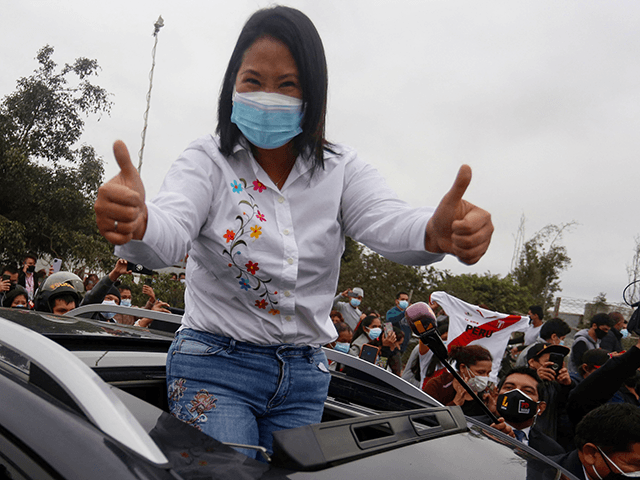The results of the presidential election in Peru on Sunday remain in a dead heat as of Monday afternoon, with a little over 34,000 votes of the 17 million separating communist candidate Pedro Castillo of the Free Peru party from conservative Keiko Fujimori and her Popular Force party.
The latest data published by Peru’s National Office for Electoral Processes (ONPE) as of 11:48 a.m. local time gave Castillo the lead with 50.102 percent of the vote. Fujimori’s total represented 49.898 percent of the vote. The 34,000-vote difference between the two candidates is smaller than the number of blank ballots (114,773 votes) and null ballots, in which a voter overtly expresses a desire to vote for neither candidate (1.013 million votes). The ONPE had counted nearly 18 million votes as of its latest tallies.
The vote typically counted fastest in Peru comes from Lima and other urban sectors, which polling throughout the presidential race showed breaking formidably for Fujimori. Fujimori maintained a slight lead for most of the vote-counting since it began on Sunday night. The margin fell on Monday morning to 4,000 votes before Castillo took the lead on the back of votes from rural Peruvian sectors.
Most of the outstanding vote is from the nation’s most remote rural areas, which are expected to go to Castillo, and votes from abroad, which are expected to go to Fujimori. ONPE had tallied 23.37 percent of the expat vote as of its last update, meaning nearly 80 percent of it has not contributed to the current total. Notably absent from the final tally at press time are 100 percent of votes from the United States – where the single largest number of votes from abroad are expected to come from – and Japan, Fujimori’s ancestral homeland. At press time, Keiko is leading the expat vote with 63.18 percent, a commanding lead over Castillo.
The extreme closeness of the race reflects the state it has been since Castillo and Fujimori secured the top two spots in the first round of presidential elections in April, which featured a large number of candidates. The Peruvian constitution requires a second “runoff” election if no candidate in the first round receives 51 percent or more of the vote. Castillo defeated Fujimori during the first round of voting and maintained a slight lead throughout the race. Last week, the polling firm Ipsos found that 51.1 percent of voters supported Castillo, while 48.9 percent supported Fujimori; the difference was almost identical to the poll’s margin of error.
Both candidates issued appeals for peace to voters following the closure of polling stations. Fujimori last commented when the ONPE results still showed her in the lead, a fact she said she “received with joy, but seeing the margin is so small it is fundamental to remain prudent and I ask that of all Peruvians.”
“Here there is no winner or loser, here what we have to do is seek finally unity among Peruvians, that is why I ask for prudence, for calm, for peace from both groups who both voted and did not vote for us,” Fujimori said.
Castillo issued an official statement late on Sunday through his political party, Free Peru. Rather than appealing for calm, Castillo preemptively demanded fully verified vote tallies, implying the potential for fraud, and demanding Peru’s Public Ministry send officials to monitor the ONPE to ensure the “judicial security” of the vote-counting process.
The slim margin dividing the two candidates is particularly dramatic given how different the visions for the country the two candidates have presented are. Castillo’s Free Peru party is openly Leninist – its party platform officially praises Vladimir Lenin and Fidel Castro. Castillo himself has vowed to write a new constitution, seize significant amounts of land for state possession, and has openly opposed LGBT rights, a staple of Latin American communism. Castillo’s running mate vowed following their first-round win that, if the two obtain the presidency, “the comfortable Lima middle class will surely cease to be a comfortable middle class.”
Fujimori, in her third presidential runoff race, is a longtime staple of Peruvian politics, entering the national spotlight as a teen during the tenure of her father, President Alberto Fujimori. Like her father, Fujimori has emphasized policies that more sternly punish crime, inviting foreign investment and foster private business, and has focused on an overhaul of Peru’s health system in light of the previous government’s poor handling of the Chinese coronavirus pandemic.
Both Castillo and Fujimori are facing criminal investigations. Peruvian police opened an investigation into Castillo in May over inconsistencies in his election filing papers, including Castillo apparently not disclosing that he held a senior position in a private corporation. Fujimori was arrested in 2018 on charges of corruption and is currently out on bail.
Current Peruvian President Francisco Sagasti assumed the position in November after the expulsion of Manuel Marino. Marino was president for five days after Congress, largely due to organizing by Fujimori’s Popular Force, expelled his predecessor Martin Vizcarra. Vizcarra became president in 2018 after Pedro Pablo Kuczynski, who defeated Keiko Fujimori in the 2016 election, resigned. Kuczynski’s had appeared in a video leaked by Popular Force officials appearing to bribe members of Congress, including Fujimori’s brother Kenji.

COMMENTS
Please let us know if you're having issues with commenting.